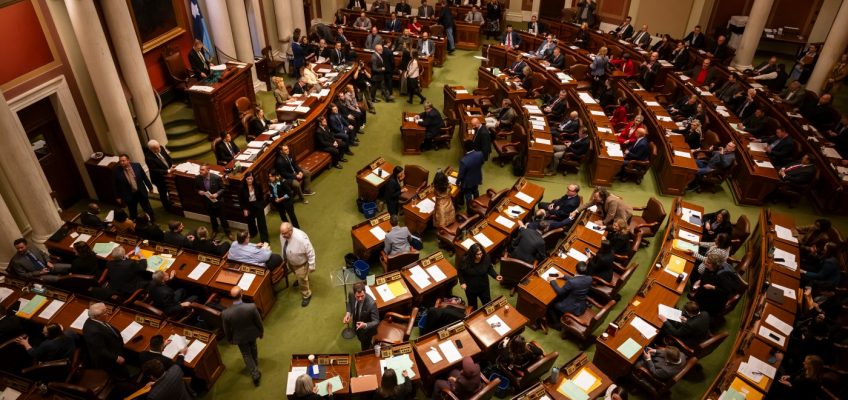Minnesota is on its way to officially recognizing the service of Hmong and Lao and other veterans who fought alongside the U.S. in the “Secret War” during the 1960s and 1970s in Laos.
A veterans and military affairs bill passed by the state House on Tuesday night creates a path to grant official state veteran status for fighters recruited into Special Guerrilla Units by the CIA during the Vietnam War to fight communist forces in Southeast Asia.
The anniversary of the fall of Saigon this week marks 50 years since the U.S. ended its involvement in Vietnam, and supporters of the bill gathered at the state Capitol with surviving veterans of the Secret War to call for greater recognition.
“Today, we say their service matters, their sacrifice matters, their story is American history,” said Rep. Jay Xiong, DFL-St. Paul, co-author of the veterans bill and the son and grandson of Hmong soldiers.
He added: “Recognizing SGUs isn’t just symbolic, it’s a long overdue act of respect.”
‘Burden of being forgotten’
Lee Pao Xiong, a professor from the Center for Hmong Studies at Concordia University, addresses the media at a Capitol news conference on Tuesday, April 29, 2025, along with state lawmakers and Hmong veterans of the "Secret War" in Laos in the 1960s and ’70s. (Alex Derosier / Pioneer Press)
Ya Lee, a Special Guerrilla Unit veteran who flew T-28 warplanes, said there is limited time to recognize surviving veterans for their sacrifices, and that they carry the “burden of being forgotten.”
Lee, who said he is among 10 remaining T-28 pilots living in the U.S., was among dozens of veterans at the Capitol on Tuesday who showed up in military uniforms to support the bill.
At a news conference promoting the bill, Rep. Kaohly Vang Her, DFL-St. Paul, said it’s not exactly clear how many SGU veterans remain in Minnesota, but that it’s likely fewer than 1,000.
During the 1960s and 1970s, many groups across Southeast Asia found themselves drawn into a U.S. war against communist forces within and beyond the borders of Vietnam.
Many faced persecution by their governments as a result, with many hundreds of thousands fleeing their homes and eventually ending up in the U.S. But official recognition for their contributions to the war efforts remained elusive for decades.
Legislation
The House passed a large veterans and military affairs bill containing the Secret War acknowledgement language by a vote of 126-6 on Tuesday, though it’ll need a little more work since it differs from the version passed by the Senate. Once those have been smoothed over in a conference committee, the House and Senate will have to vote once again before it can go to Gov. Tim Walz.
If signed into law by the governor, the bill would create a definition for veterans of the Secret War in Laos and criteria for eligibility for benefits and privileges for veterans. Those include designation as a veteran on driver’s licenses and ID cards, access to state veterans cemeteries, and access to preference in private employment.
Anyone who became a citizen under the Hmong Veterans Naturalization Act of 2000 will automatically get Secret War veteran status. Eligibility also extends to those who received a Medal of Honor, Purple Heart or other military award for service in support of the U.S. military operating in Laos.
Beyond immediate recognition of veterans who got citizenship for their service, the Minnesota commissioner of Veterans Affairs would be empowered to recognize veterans who served with a special guerrilla unit or other forces that operated from a base in Laos between February 1961 and May 1975.
State task force
A state task force created by the bill is charged with overseeing the process for official recognition. It is to include the Minnesota veterans commissioner, a U.S. Veterans Affairs Department official, a Hmong American Minnesota resident who served in the military, two Secret War veterans, a U.S. Vietnam veteran and other history and veterans’ issues specialists.
While the bill creates a process to recognize anyone involved in the Secret War in Laos, a group backing a bill earlier this legislative session to recognize Vietnamese, Lao and Cambodian veterans expressed disappointment that language didn’t mention those groups by name.
Bana Soumetho, who was born to Lao refugee parents in Thailand and has been working to establish explicit recognition for a broader group of Secret War veterans in state law, expressed her frustration in an email.
“This year marked what may have been the final meaningful opportunity for many of our aging veterans to receive public acknowledgment,” she wrote. “Instead, it became a painful reminder of how easily their stories can be overlooked — even when the intent is recognition.”
Related Articles
Disability funding, taxes at issue as MN Legislature crafts state budget
Ethics panel: MN Senate President must disclose possible future conflicts
Concern over vaccine misinformation prompts UMN initiative to preserve data
Walz seeks GOP help on budget, blasts Trump ‘chaos’ in State of the State speech
Jim Gelbmann: Our partisan endorsement process is unrepresentative, polarizing and self-serving




